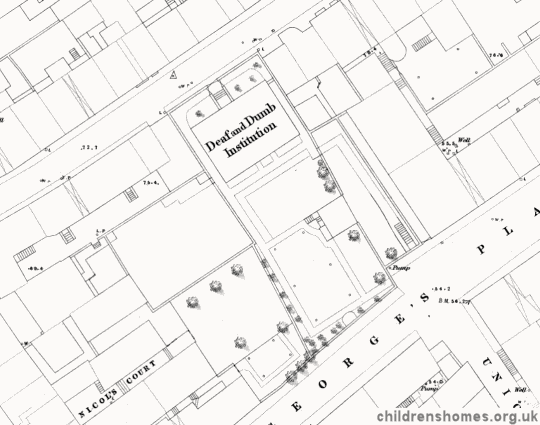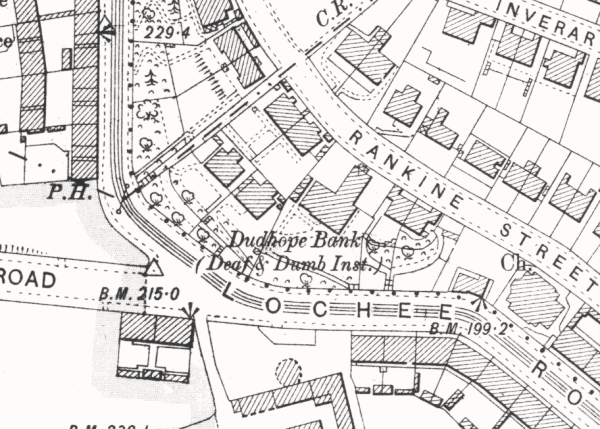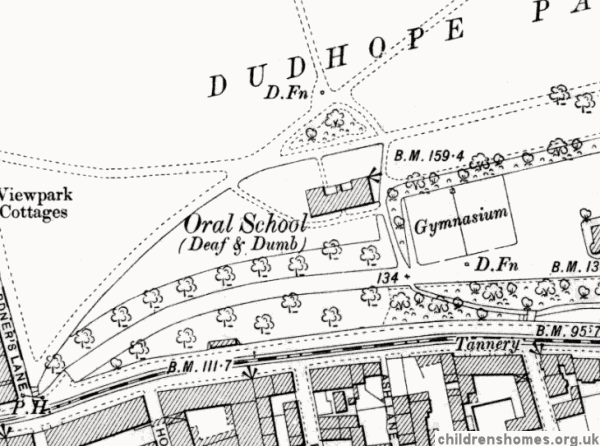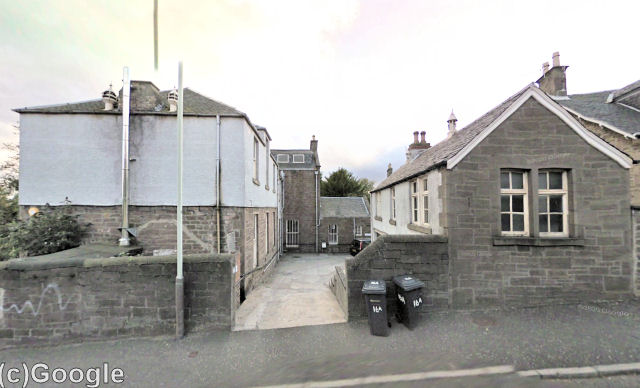Dundee Institution for the Education of Deaf and Dumb, Dundee, Angus (Forfarshire), Scotland
In 1817, Robert Kinniburgh, head of the Edinburgh Institution for the Deaf and Dumb, visited Dundee to give a talk about his work at a public meeting. He was accompanied by some of his pupils, who gave demonstration of the result he had achieved. The aim of the visit was to encourage the formation of an auxiliary branch of the charity, which would raise funds to send deaf children from Dundee to the Edinburgh Institution. However, such was the enthusiasm that resulted from his visit that there were suggestions a similar institution be founded in Aberdeen. James Rattray, a poor theological student, who had a deaf brother, put himself forward as a potential teacher and despite his having had no formal training was given several children to teach. His efforts proved unsuccessful, however, and appears to have closed after three or four years. By 1826, Dundee had returned to sending deaf children to the Edinburgh Institution and an Auxiliary Society had been formed in the town.
The idea of local institution in Dundee did not go away, however, and on 9 July 1846 the privately run Institution for the Education of the Deaf and Dumb was opened at 15 Meadow Street. Its founder was Alexander Drysdale, himself a deaf-mute, who had previously taught in the day school for the deaf in Edinburgh that had closed in the previous January. After the new establishment proved to be financially unviable as private concern, Drysdale managed to raise interest in providing a degree of charitable support for it. The following year saw the formation of the Dundee Association for the Education of the Deaf and Dumb, whose funds used to pay the fees for the education and board of the children of poor parents, However, the Association had no say in the running of the school, which remained entirely in the hands of Drysdale. The new arrangement led to an increase in the number of pupils at the school and in 1848, it was moved to larger premises at Sunnyside House, 15 Bucklemaker Wynd (now Victoria Road), Dundee. The site is shown on the 1858 map below.

Dundee Institution for the Deaf and Dumb site, Dundee, c.1858.
In 1866, the Institution received a welcome boost to its funding when Mr. James Key, of Lochee, bequeathed the residue of his estate for the maintenance and education of poor deaf and dumb children residing in Forfarshire. Under this bequest, about nine or ten pupils were provided for annually.
In 1870, when Bucklemaker Wynd was widened and redeveloped to become Victoria Road, the school temporarily transferred to Provost Road, before moving to purpose-built accommodation at Dudhope Bank, 165 Lochee Road, Dundee. The site is shown on the 1858 map below.

Dundee Institution for the Deaf and Dumb site, Dundee, c.1903.
Alexander Drysdale died in 1880 and directors of the Association took over the school. Drysdale's nephew, James Barland, was appointed as headmaster. Barland, who was himself deaf, had previously taught for some time at Dundee before moving to the Cambrian Deaf Institution at Swansea.
In 1885, the Dundee School Board decided to start their own day school for deaf children, as there was some local dissatisfaction with the teaching methods at the Institution and it was considered that it would be beneficial if there was a school under School Board control. A teacher, Miss Ellen Crasweller, was obtained from the Training College of the Association for the Oral Instruction of the Deaf and Dumb, 11 Fitzroy Square, London. As its names indicated, the establishment promoted the use of the oral method — teaching children vocal articulation and lip-reading rather than the hand gestures and finger-spelling of the manual system. From the beginning, teaching at the Board school was based purely on the oral system. On 24 June 1886, the Director of the college, William Van Praagh gave a lecture about his methods and children from the Board school were used to demonstrate its use. In 1889, the Upper Hall of Gillfillan Memorial Church was taken over for use of the school. It moved to Euclid Crescent in 1892 and then to Dudhope Park on Lochee Road in 1900.

School Board Oral School, Dudhope Park site, Dundee, c.1901.
Following the construction of Rankine Street at the north side of Dudhope Bank, the Institution moved its entrance to the new road, its address then becoming 14 Rankine Street.
The regulations for admission to the Institution were stated in 1890 as being:
As the regulations made clear, the primary mode of instruction was by the manual system, although the increasingly popular oral system had made some inroads into the Institution. This is perhaps not surprising as both of its first two headmasters were themselves deaf and not able to to provide any speech teaching. The headmaster's report in 1894 described the aim of the teaching as being "to enable the children to have a command of simple written language." The school was divided into two classes: the Junior, or Word Class, and the Senior, or Language Class. The children in the Word Class were promoted to the Language Class as soon as they knew the names of 100 common things. In the Language Class there were two divisions: the higher, which learned every full sentence as a lesson, and the lower, which after leaving the Word Class, learned a part of each sentence gradually, until they were able to join the higher in learning full sentences. They were given a sentence to commit to memory, to explain it, and to answer questions on it.
In 1896, All the pupils were taught sewing and knitting. Training in laundry work was introduced for the girls in 1898, followed by cookery. The Institution timetable in 1898 is shown below:
| 9.30 am. | Prayer and Religious Instruction | |
| 10 a.m. | Mon/Wed/Fri | Government Needlework & Kindergarten |
| Tue/Thu | Drawing | |
| 11 a.m. | Arithmetic and Numeration | |
| Tue | Cookery for Senior Girls | |
| Thu | Laundry-work for Senior Girls | |
| 12.00 | Break | Recreation, Dinner, &c. |
| 2 p.m. | Juniors | Writing and Spelling; Signing the names of Common Things; Short Sentences from Object Lessons. |
| Seniors | Writing in Copybooks | |
| 2.30 p.m. | Seniors | Mon/Wed/Fri — Language & Composition |
| Tue — Geography | ||
| Thu — History & General Information. | ||
| 3.30 p.m. | Seniors | Composition — Sentences from Illustrated Papers. |
| 4 p.m.. | Benediction. | |
| Sunday | 11.30 a.m. | Divine Service |
| 3 p.m. | Sabbath School | |
| 6.30 p.m. | Explanation of Bible Pictures | |
| The morning is devoted to housework — Before breakfast: sweeping the children's rooms downstairs, tidying the grounds, outhouses, &c.; After breakfast: making beds, sweeping the children's rooms upstairs, &c. | ||
In 1903, instruction in brass work began and a gymnasium was fitted out. For an hour each week, a visiting PT instructor demonstrated each exercise, then, by means of tapping his foot, had them repeat it several times with a rhythm that soon became perfect.
James Barland resigned in 1902 and was succeeded by Robert Hansell, with Mrs Hansell as the Institution's matron. Hansell was the Institution's first hearing teacher and, under his tenure, use of the the oral system increased. In 1904, two assistant teachers were appointed, allowing much more individual attention to be given to the children. Numbers at the Institution rose from the previous usual twenty or so to thirty in 1910.
At the Board school, Miss Crasweller resigned in May 1904 to take charge of the new day school at Aberdeen. Her successor had only been in office for a couple of months when it was decided to abandon oralism in favour of the combined method — making use of both the oral and manual systems.
In 1911, new classrooms were added to the Institution building to make additional provision for manual craft and trade instruction, which eventually included boot making, woodwork, brass work, clay and cardboard modelling and raffia work. In 1912, swimming instruction was introduced.

Former Dundee Institution for the Deaf, Rankine Street, Dundee, 2104.
Robert Hansell remained as head of the Institution until October 1939. It and the Day School were evacuated to Belmont Castle, Meigle, Perthshire, with some residential pupils remained there until 1947. The Day School resumed operation in 1940.
The Dundee Institute for the Deaf ceased its teaching activities in 1947. When its 22 evacuated pupils returned to Dundee, they began attending the Day School. The Rankine Street premises were then used as a hostel for its residential pupils, then later as a day nursery. The building was demolished in 2015.
Records
Note: many repositories impose a closure period of up to 100 years for records identifying individuals. Before travelling a long distance, always check that the records you want to consult will be available.
- Dundee City Archive & Record Centre, 21 City Square Dundee, DD1 3BY. Holdings: Log books; Admissions and Lefts' Registers; Visitors' Book; Amateur films of social events; Miscellaneous papers
Headmasters
- 1846-80 — Alexander Drysdale
- 1880-1902 — James Barland
- 1902-39 — Robert Hansell
- 1939-47 — Evacuated
- 1947 — Amalgamated with Day School
Pupils
Bibliography
- Boyce, Anthony J; Bruce, Pamela Loyal and True: The Life and Times of Alexander Drysdale (1812-1880) (2011, Deafprint Winsford)
- Higginbotham, Peter Children's Homes: A History of Institutional Care for Britain's Young (2017, Pen & Sword)
- Pritchard, D.G., Education and the Handicapped 1760-1960 (1963, Routledge & Kegan Paul)
- Watson, J, Instruction of the Deaf and Dumb (1809)
- Watson, Thomas J., A History of Deaf Education in Scotland 1760-1939 (Unpublished PhD Thesis, University of Edinburgh, 1949)
Links
Except where indicated, this page () © Peter Higginbotham. Contents may not be reproduced without permission.


